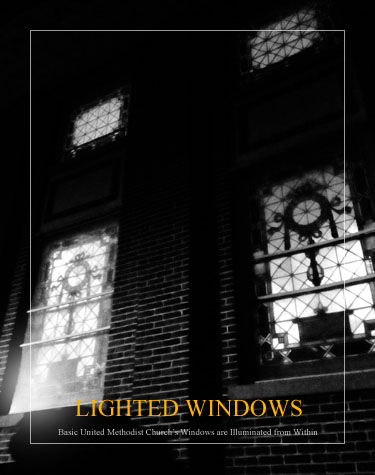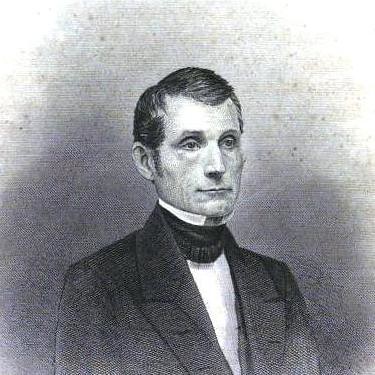
Volume X, Issue IX
Lighted Windows
One of the Pastors who led the community prayer meeting at Basic United Methodist Church last night reflected: "I was excited to see the windows of the church illuminated as I drove up tonight. You used to see a lot of church windows lit up on a Wednesday or a Sunday night." He lamented the sad reality that that is no longer the case. Indeed many within the church are resigning themselves, it seems, to her 'inevitable' demise. Yet here in a historic sanctuary in Waynesboro,Virginia we are a small group proclaiming otherwise. The Pastor goes on to envision a whole countryside full of church buildings illuminated from within. Much like Jeremiah Lanphier in the Nineteenth Century, there are those who hold fast to the Divine in Faith and pray for better.
J. Lanphier's Journey of Prayer
How A Nation Was Turned to G-d and Restored

Jeremiah Lanphier discovered the power of prayer in his own life.
By the middle of the Nineteenth Century, America found herself at a crossroads. Wild speculation and greed had built a house of cards. While a few became incredibly wealthy, the gap between haves and have-nots grew ever wider. The economic crash had put 30,000 men out of work on the streets of New York City. Churches languished as people explored Spiritism and other "new" ideas. We, of the Twenty-first Century, would find the condition of the culture strangely familiar.
Political corruption, shady dealings in business and a general moral decline were the norm. "Atheism, agnosticism, apathy and indifference to God, to the church, and its message abounded on every hand. The decline was fourfold: social, moral, political and spiritual." -- Tom Shanklin
Then came the crash! Factories were shuttered. Banks failed and merchants were ruined. Thousands were destitute. Winkie Pratney, who chronicled the great revival, says: "A near socio-economic collapse jolted America away from her apathy into a national cry for spiritual reality." Chuck Balsamo presents a wonderful concise history of this revival in his book Make Me a Legend [click to read]. The story does not begin with a mighty move and thousands of conversions, rather it begins in a rather small way.
Jeremiah Lanphier was a middle-aged businessman caught in the crossroads. Having no children and no family, he was drawn to minister to the needs of those living in the dark slums of Hell's Kitchen. Leaving his business, he became a lay missionary with the North Dutch Church in Manhattan. Pouring his life into the lives of those he saw caught in hopelessness, he soon came to the end of his own strength. Physically and mentally exhausted, Lanphier discovered that just as the body needs food, the soul and spirit of a man need to be nourished in prayer.[1.]
Each day at midday, Lanphier would seek solace in the Church Consistory Building, where he would cry out to G-d for spiritual strength. He experienced G-d in a mighty way in these times and felt that others would benefit from prayer as well, especially the city's businessmen. He printed up and distributed 20,000 flyers advertising his first noontime prayer meeting, on September 23, 1857.
That day he prayed alone for thirty minutes before six others joined him. The next week there were twenty. The week after that forty people showed up. In time over 100 churches had noonday prayer meetings going throughout the city. G-d's powerful move was felt far beyond New York City. Newspaperman Horace Greeley wanted to get a count of the number of men praying in New York so he sent a reporter out to the meetings. Racing around the city in a horse-drawn buggy, the reporter was only able to get to twelve meetings in the noon hour, but he counted 6,100 in attendance.
Spiritual awakening followed and Americans found strength in G-d for the turbulent days that followed. This Third Great Awakening not only revitalized the spirit of America's people, but led to missionary outreach around the world. [2.]
The Prayer Meeting
that Touched the World
Moravians Prayed Around the Clock for 100 Years

The village of Herrnhut in Saxony.
The Moravian Brethren Church was born in the 1720's when Count Nikolaus Ludwig von Zinzendorf gave refuge to persecuted Hussites from Moravia and Bohemia. The village of Herrnhut, Saxony, now a part of Germany, was built by them.
Count Zinzendorf started a round-the-clock prayer meeting in 1727. It lasted one hundred years. People in Herrnhut signed up to pray for an hour a day.
What G-d did as a result of that prayer meeting is amazing. In an era when travel was difficult and dangerous the Moravians became a major force in reaching the world with the Gospel. Their ministry took them to many parts of the world. Moravians settled in the new world in Pennsylvania. The cities of Bethlehem and Nazareth are Moravian settlements. Count Zinzendorf secured a large tract of land in North Carolina where the Moravians established Bethabara. From here they began outreach to the Native Americans around them.
In 1753, Moravians from North Carolina travelled into the Cherokee Nation, which extended into North Georgia and Alabama from Western North Carolina. The nonacquisitive Moravians eventually developed a long standing ministry among the Cherokee. Since unmarried Moravian men and women lived in communal houses, one house for men and another for women, they may have been philosphically closer to a long house people than other Europeans. The New Georgia Encyclopedia states of them:
Generally, the accomplishments of the Moravians lay in the fact that their missions not only opened their doors to all visitors, including African slaves from nearby Cherokee plantations, but also functioned as model farms for European agricultural techniques. Particularly, the Spring Place Mission served as an exemplar for other missionary enterprises to emulate."
The Moravians certainly were lovers of innovation in agriculture and craftsmanship. Visit the restored Moravian settlement in Salem, North Carolina today and you will see some of the first water pipes in America -- hollowed logs with metal couplings -- that carry water inside the Single Brothers' House.
The Light Within
It has been said that: "The blood of the martyrs is the seed of the Church." As the country mourns the victims of another senseless violent rampage, let us not forget that there are young people at an Oregon college who were willing to die for their Faith. A friend of mine, only a bit older than the victims, writes: "A Christian martyr is a person who is killed for following Jesus and never denies Jesus as Lord, to the point of death. Praise God for these witnesses of faith, even today!"
Yes, these young saints, they are among these mentioned in Revelation 6: “And when he had opened the fifth seal, I saw under the altar the souls of them that were slain for the word of God, and for the testimony which they held: And they cried with a loud voice, saying, How long, O Lord, holy and true, dost thou not judge and avenge our blood on them that dwell on the earth? And white robes were given unto every one of them; and it was said unto them, that they should rest yet for a little season, until their fellowservants also and their brethren, that should be killed as they were, should be fulfilled.”
-- Revelation 6:9-11
So, even in the midst of this terrible rampage, G-d shines on in His work and purpose. I find in this moment a personal challenge... to catch the torch from the hands of the slain, and live as one illuminated from within by the Love of Christ myself. It is not an easy one, but the G-d who seeks to make all things new asks no less. May we, His people, prayerfully step up to the challenge.